Airfix 1/48 scale
Supermarine Spitfire Mk.XII
by Cameron Lynch
|
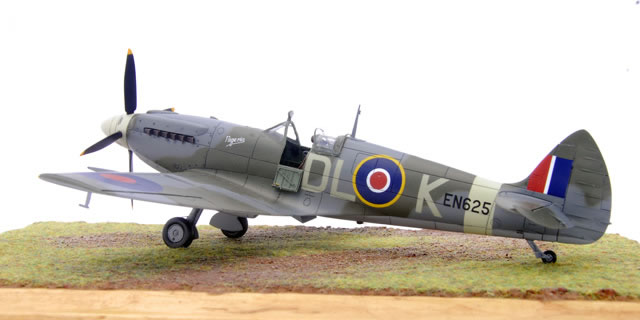
|
Spitfire XII EN625
Squadron Leader R.H. Harries, D.S.O, D.F.C. and two bars
91 Squadron
Westhampnett, West Sussex
25 May, 1943 |

Airfix's 1/48 scale Spitfire XII is available online from Squadron for only $16.99
Raymond Harries is the highest scoring Welshman during the second world war. A dental student when the war began, Harries joined the RAF, eventually being given command of 91 “Nigeria” Squadron in January 1943.
In April 1943 91 Squadron traded in their Spitfire Vb’s for the new Spitfire XII, becoming the first unit equipped with the Griffon powered Spitfire. 91 Squadron was assigned to the defense of southeast England, initially using the high performance Spitfire XII to counter hit and run raids by Fw 190s and later chasing V-1 flying bombs launched from France. Harries was the most successful Spitfire XII pilot during the war, downing two Fw 190s over Folkestone on 25 May. This initial success was followed by 2.5 more Fw 190s and six Bf 109s during the summer and fall of 1943.
Harries finished the war as a Wing Commander with 15 confirmed destroyed, 3 shared, 2 probables and 5 V-1s destroyed.
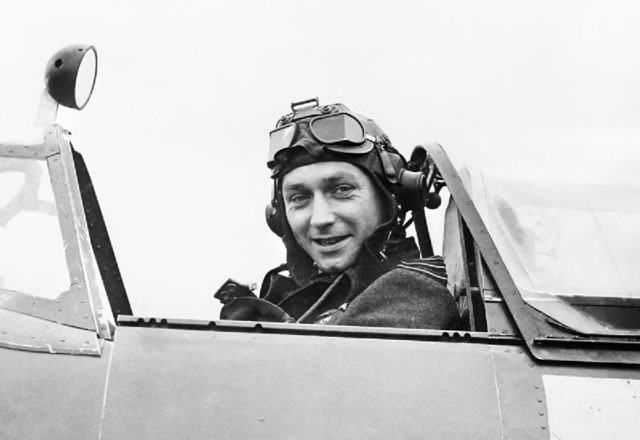
Wing Commander Harries was killed bailing out of a Meteor in 1950.
I’ve always loved the muscular look of the Griffon powered Spitfire marks. I’ve got a couple of the Academy Spitfire XIVs in my collection, but have always been put off by the amount of work that it would take to correct them. I was excited when Airfix released their new Spitfire XII kit, ordering one each from the UK rather than waiting until they were released here in the US. While the kit wasn’t up the high standards established previously by their lat mark Spitfire/Seafire kits, or their spectacular Lightnings, the kits looked eminently buildable. I already had a couple copies of the superb Victory Productions “Aces of the Empire” decal sheet so there was little doubt which markings that I planned on using.
I started with the cockpit. I felt that the moulding on some of the bits and bobs on the cockpit sidewalls were a bit soft and resolved to replace them. I used a dremel tool to grind off all the detail forward of the seat bulkhead on both fuselage halfs. I thinned the plastic, cut out the access door, and then used some 3m blue glazing putty to fill inadvertent divots and wet sanded the fuselage sides smooth. I then used the resin lower sidewalls from the old Cooper Details Spitfire I-V cockpit set. I replaced the stringers and longerons with Evergreen strip. I then used various resin parts from the Cooper Details set such as the throttle, landing gear selector, oxygen hose, etc. to replace the detail above the longerons.

I replaced the oxygen bottles with resin versions from an Aires Spit 9 cockpit. I didn’t care for the Airfix instrument panel, so I used the pre-painted one from the Eduard Spitfire XII set for the Airfix kit. The prominent compass is styrene rod with the Eduard compass face. The various hydraulic and electrical cables were duplicated using fine lead wire and solder.
The geometry of the Spitfire cockpit with its open floor and multiple bulkheads is tricky, and while I tried to limit my work to the sidewalls AMS took over and made my life more complicated. I started with the seat bulkhead, drilling out all of the lightening holes. I used styrene sheet for the back armor plate and replaced the head armor and leather padded head rest with one from the Cooper Details set.
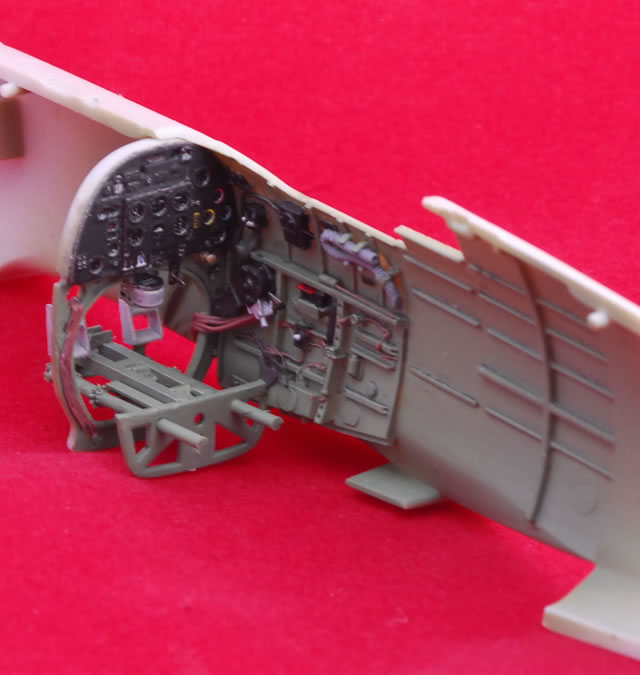
The kit seat was replaced with an Ultracast seat with the harness already molded on. The shelf behind the seat and the aft bulkhead were from the kit, although I replaced the voltage regulators and pressure bottle with resin from various sources. The Eduard set included a lovely etched harness mount. I replaced the brace between the two aft bulkheads at the top with some Evergreen T structural shape. This meant that everything from the seat back was completed.
Now I had to take the instrument panel/bulkhead and make it fit the rudder pedal/control column structure and the low bulkhead under the front of the seat…all while preserving the geometry and making it fit.
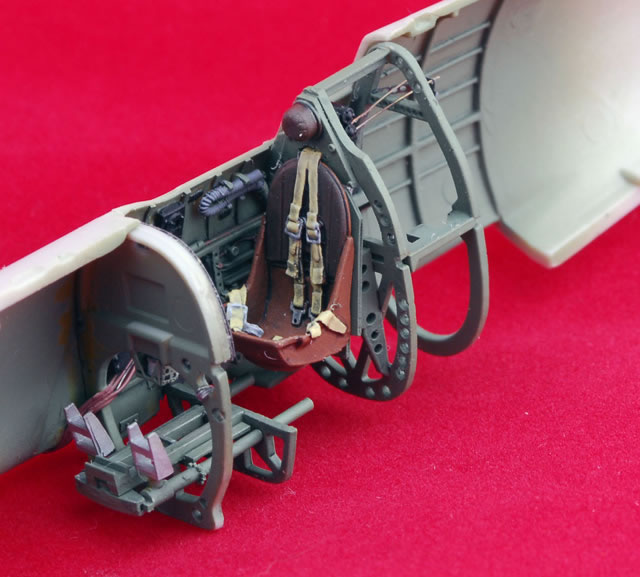
My first attempt using the kit rudder pedal structure failed. Horribly. I ended up destroying the part leaving me with only the bulkhead. Ultimately I had to scratchbuild the whole thing myself using Evergreen strip, structural shapes and rods. The rudder pedals were sourced from Cooper Details, along with the bar that connected the pedals to the control rods. The pedal adjustment knobs were replicated with watch parts. After a bunch of careful test fitting and adjustment everything fit together and the fuselage halves closed together without any problems.
The major portions of kit assembly were trouble free, and pretty fast. In short order it started to look like a plane. I opted to leave the flaps up as Spitfires only had their flaps down during landing…never when parked. Some Eduard parts were used for the radiator and oil cooler. I replaced the kit gun barrels with resin bits from Ultracast, as well as the main wheels. I made some resin copies of the Hasegawa Spitfire IX main gear doors and tail wheel which I felt were better detailed than the Airfix parts. The exhausts were sourced from a Quickboost set, as was the antenna mast. The little scoop on top of the engine, as well as the spinner and props were taken from a Paragon resin Spitfire XII conversion set. The gunsight and the cockpit door were from Cooper Details. The windscreen is from the kit, but the sliding canopy and rear canopy were sourced from a couple of Squadron Spitfire canopy sets.
The aircraft was painted using some stashed Aeromaster acrylics. National markings were from an old Aeromaster sheet. Stenciling was from the Barracuda Studios Spitfire sheet and the individual aircraft markings were from the aforementioned Victory Models sheet.
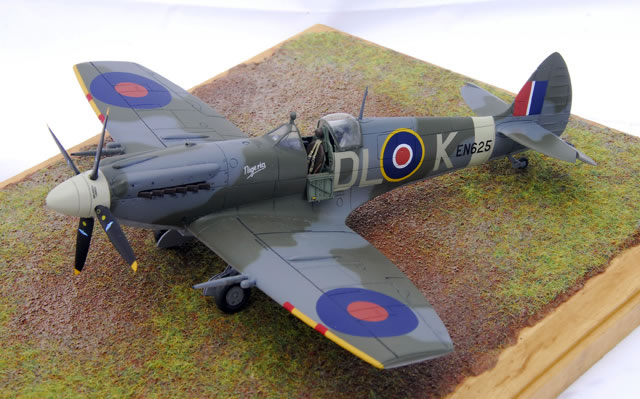
It was lightly weathered, primarily an oil wash and then given a light sheen with a clear coat that evened everything out.
All in all, Airfix has a winner here.
Some of the details are a little soft, but the important stuff is very nice. There have been some complaints about the recessed panel lines being a bit matchbox-like. I didn’t touch them except to restore areas that were damaged during seam work.
Under some paint and given a little wash and they look good to me. I’m very pleased with the results and it won’t be the last of the new Airfix kits that I will build.

Model, Images and Text Copyright ©
2012 by Cameron Lynch
Page Created 30 May, 2012
Last Updated
30 May, 2012
Back to
HyperScale Main Page |
Home
| What's New | Features | Gallery | Reviews | Reference | Resource Guides | Forum |